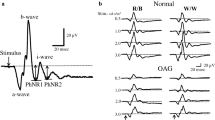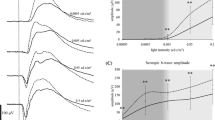Abstract
Dark-adapted electroretinograms were obtained over a 3.6-log range of stimulus intensities from 17 black and 15 white normal subjects. Subjects were grouped on the basis of light or dark fundus pigmentation, determined from digitized fundus photographs. B-wave amplitudes for each group were fitted by the Naka-Rushton equation, and the measures Vmax, log K, and n were determined. The luminance-response functions revealed that subjects with light fundi had larger b-wave amplitudes at all luminance levels. There was a significant difference between groups for Vmax and n but not for log K. A comparison of b-wave implicit times showed no significant difference between subjects with dark and light fundi. Ancillary tests and multiple regression analysis suggested that the relationship between Vmax and fundus pigmentation could not be attributed to age, gender, refractive error, axial length or intraocular pressure. The results have implications for the collection of normative electroretinographic data and for the interpretation of electroretinogram results.
Similar content being viewed by others
Abbreviations
- AL:
-
axial length
- FPH:
-
fundus pigmentation heterogeneity
- IOP:
-
intraocular pressure
- L-R function:
-
luminance-response function
- ND:
-
neutral density
- RE:
-
refractive error
- sph eq:
-
spherical equivalent.
References
Naka KI, Rushton WAH. S-potentials from color units in the retina of fish (Cyprinidae). J Physiol 1966; 185: 536–55.
Wu L, Massof RW, Starr SJ. Computer-assisted analysis of clinical electroretinographic intensity-response functions. Doc Ophthalmol Proc Ser 1983; 37: 231–9.
Birch DG. Clinical electroretinography. Ophthalmol Clin North Am 1989; 2: 469–97.
Peachey NS, Alexander KR, Fishman GA. The luminance-response function of the dark-adapted human electroretinogram. Vision Res 1989; 29: 263–70.
Wali N, Leguire LE. Dark-adapted luminance-response functions with skin and corneal electrodes. Doc Ophthalmol 1991; 76: 367–75.
Aylward GW. A simple method for fitting the Naka-Rushton equation. Clin Vision Sci 1989; 4: 275–7.
Wali N, Leguire LE. On the method for fitting the Naka-Rushton equation: Corrections to Aylward (1989). Clin Vision Sci 1989; 6: 79.
Arden GB, Carter RM, Hogg CR, Powell DJ, Ernst WJK, Clover GM, Lyness AL, Quinlan MR. A modified ERG technique and the results obtained in X-linked retinitis pigmentosa. Br J Ophthalmol 1983; 67: 419–30.
Birch DG, Fish GE. Rod ERGs in retinitis pigmentosa and cone-rod degeneration. Invest Ophthalmol Vis Sci 1987; 28: 140–50.
Johnson MA, Marcus S, Elman MJ, McPhee TJ. Neovascularization in central retinal vein occlusion: Electroretinographic findings. Arch Ophthalmol 1988; 106: 348–52.
Kaye SB, Harding SP. Early electroretinography in unilateral central retinal vein occlusion as a predictor of rubeosis iridis. Arch Ophthalmol 1988; 106: 353–6.
Breton ME, Quinn GE, Keene SS, Dahmen JC, Brucker AJ. Electroretinogram parameters at presentation as predictors of rubeosis in central retinal vein occlusion patients. Ophthalmology 1989; 96: 1343–52.
Fulton AB, Hansen RM. Scotopic stimulus/response relations of the B-wave of the electroretinogram. Doc Ophthalmol 1988; 68: 293–304.
Aylward GW, Jeffrey BG, Billson FA. Normal variation and the effect of age on the parametric analysis of the intensity-response series of the scotopic electroretinogram, including the scotopic threshold response. Clin Vision Sci 1990; 5: 353–62.
Wali N, Leguire LE. Utilization of skin electrodes for recording scotopic intensity response curves in minority populations [ARVO Abstracts]. Invest Ophthalmol Vis Sci 1990; 31(suppl.): 2073.
Kilbride PE, Read JS, Fishman GA, Fishman M. Determination of human cone pigment density difference spectra in spatially resolved regions of the fovea. Vision Res 1983; 23: 1341–50.
Faulkner DJ, Kemp CM. Human rhodopsin measurement using a TV based imaging fundus reflectometer. Vision Res 1984; 221–31.
Schmidt B. Sensorial examination in an African albino child. Acta Fac Med Univ Brumen 1965; 25: 83–9.
Dodt E, Copenhaven RM, Gunkel RD. Electroretinographic measurement of the spectral sensitivity in albino, Caucasians, and Negroes. Arch Ophthalmol 1959; 62: 87–95.
Creel D. Inappropriate use of albino animals as models in research. Pharmacol Biochem Behav 1980; 12: 969–77.
Moloney JB, Mooney DJ, O'Connor MA. Retinal function in Stargardt's disease and fundus flavimaculatus. Am J Ophthalmol 1983; 96: 57–65.
Birch DG, Fish GE. Rod ERGs in children with hereditary retinal degeneration. J Pediatr Ophthalmol Strabismus 1986; 23: 227–32.
Dorey KC, Gloria W, Ebenstein D, Garsd A, Weiter JJ. Cell loss in the aging retina: Relationship to lipofuscin accumulation and macular degeneration. Invest Ophthalmol Vis Sci 1989; 30: 1691–9.
McGinness J, Proctor P. The importance of the fact that melanin is black. J Theor Biol 1973; 39: 677–8.
Gan EV, Haberman HF, Menon IA. Electron transfer properties of melanin. Arch Biochem Biophys 1976; 173: 666–72.
Weiter J, Delori FC, Wing GL, Fitch KA. Relationship of senile macular degeneration to ocular pigmentation. Am J Ophthalmol 1985; 99: 185–7.
Weiter J, Delori FC, Wing GL, Fitch KA. Retinal pigment epithelial lipofuscin and melanin and choroidal melanin in human eyes. Invest Ophthalmol Vis Sci 1986; 27: 145–52.
Wali N, Leguire LE. Dependence of the dark adapted ERG on fundus heterogeneity [ARVO Abstracts]. Invest Ophthalmol Vis Sci 1991; 32(suppl.): 928.
Nordlund JJ. The lives of pigment cells. Clin Geriatr Med 1989; 5: 91–108.
Author information
Authors and Affiliations
Rights and permissions
About this article
Cite this article
Wali, N., Leguire, L.E. Fundus pigmentation and the dark-adapted electroretinogram. Doc Ophthalmol 80, 1–11 (1992). https://doi.org/10.1007/BF00161226
Accepted:
Issue Date:
DOI: https://doi.org/10.1007/BF00161226




